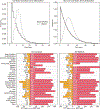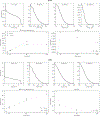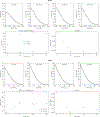HEDOS-a computational tool to assess radiation dose to circulating blood cells during external beam radiotherapy based on whole-body blood flow simulations
- PMID: 34293735
- PMCID: PMC8720566
- DOI: 10.1088/1361-6560/ac16ea
HEDOS-a computational tool to assess radiation dose to circulating blood cells during external beam radiotherapy based on whole-body blood flow simulations
Abstract
We have developed a time-dependent computational framework, hematological dose (HEDOS), to estimate dose to circulating blood cells from radiation therapy treatment fields for any treatment site. Two independent dynamic models were implemented in HEDOS: one describing the spatiotemporal distribution of blood particles (BPs) in organs and the second describing the time-dependent radiation field delivery. A whole-body blood flow network based on blood volumes and flow rates from ICRP Publication 89 was simulated to produce the spatiotemporal distribution of BPs in organs across the entire body using a discrete-time Markov process. Constant or time-varying transition probabilities were applied and their impact on transition time was investigated. The impact of treatment time and anatomical site were investigated using imaging data and dose distributions from a liver cancer and a brain cancer patient. The simulations revealed different dose levels to the circulating blood for brain irradiation compared to liver irradiation even for similar field sizes due to the different blood flow properties of the two organs. The volume of blood receiving any dose (V>0 Gy) after a single radiation fraction increases from 1.2% for a 1 s delivery time to 20.9% for 120 s delivery time for the brain cancer treatment, and from 10% (1 s) to 48.7% (120 s) for a liver cancer treatment. Other measures of the low-dose bath to the circulating blood such as the dose to small volumes of blood (D2%) decreases with longer delivery time. Furthermore, we demonstrate that the blood dose-volume histogram is highly sensitive to changes in the treatment time, indicating that dynamic modeling of blood flow and radiation fields is necessary to evaluate dose to circulating blood cells for the assessment of radiation-induced lymphopenia. HEDOS is publicly available and allows for the estimation of patient-specific dose to circulating blood cells based on organ DVHs, thus enabling the study of the impact of different treatment plans, dose rates, and fractionation schemes.
Keywords: discrete-time Markov process; lymphopenia; radiation dose to lymphocytes; radiotherapy; whole-body blood flow.
© 2021 Institute of Physics and Engineering in Medicine.
Figures












References
-
- Borgmann K et al. 2008. Individual radiosensitivity measured with lymphocytes may predict the risk of acute reaction after radiotherapy Int.J. Radiat. Oncol. 71 256–64 - PubMed
-
- Byun HK,Kim N, Park S and Seong J 2019. Acute severe lymphopenia by radiotherapy is associated with reduced overall survival in hepatocellular carcinoma Strahlenther. Onkol. 195 1007–17 - PubMed
-
- Catalano OA, Singh AH, Uppot RN, Hahn PF, Ferrone CR and Sahani DV 2008. Vascular and biliary variants in the liver:implications for liver surgery RadioGraphics 28 359–78 - PubMed
Publication types
MeSH terms
Grants and funding
LinkOut - more resources
Full Text Sources
Other Literature Sources
